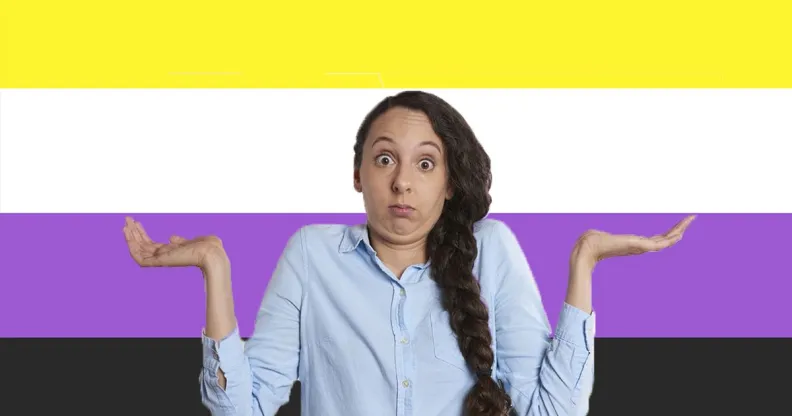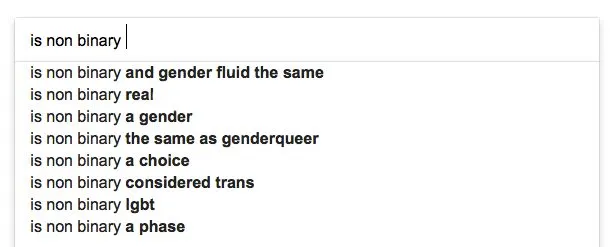Non-binary: The term for people who aren’t exclusively male or female

(Photo: Creative Commons)
(Photo: Creative Commons)
There’s been a lot of talk about gender and non-binary people recently.
Over the last few years, the visibility of trans and non-binary people has exploded, with many people using their voices to promote social change and acceptance both in and outside of the LGBT+ community.
Non-binary people took center stage during this year’s Trans Day of Visibility (TDOV), using the hashtag #ThisIsWhatNonBinaryLooksLike to promote the misunderstood identity.
While the visibility of non-binary people is increasing, the general understanding of gender and identity, and what the term actually means, is still lacking.
A quick search shows that people really do have a lot of questions about being non-binary, and what the word means exactly.

Let’s get down to business (Google)
We’ve all got to learn at some point — after all, no one leaps into the world with a complete understanding of gender — it’s time to debunk some myths and answer some questions.
So, what is non-binary?
Non-binary is a broad term to describe a gender identity that isn’t exclusively male or female.
Gender is a spectrum. While a lot of people are at either end, a lot of people are in the middle. Non-binary people can identify with various degrees of masculinity and femininity, androgyny or have no gender at all.
Some non-binary people will feel completely androgynous and fall right in the middle of the spectrum, while others will lean more towards being more masculine or feminine.
As well as being an identity in itself, non-binary is also sometimes used as an umbrella term that can include other identities including agender (not having a gender), bigender (having two genders) and genderfluid (having a shifting gender identity).
Gender is made up of two key parts — how a person feels inside (their gender identity) and how they show this, including how they dress, their name and the pronouns they use (their gender expression).
These are both separate from biological sex, which is assigned at birth based on a baby’s external genitals.
It’s pretty important to know the differences between the three. If you’re still a bit confused, drag queen Courtney Act breaks down the basics of gender.
Related: Billions features groundbreaking non-binary sex scene
Got it?
If you like the sound of that then check out Courtney Act’s interview with PinkNews, where she discusses how being gender-fluid has set her free.
Is non-binary real or is it a trend?
You might have heard some people say that non-binary is made up, invented by hip millennials who are too ‘trendy’ to want to be male or female.
That’s not how this works.
Non-binary and third genders predate millennials and their avocado toast eating by around 4000 years.
There are references to third genders in Mesopotamian mythology dating back to around 2000 BC, and also on pottery shards from Ancient Egypt.
Multiple countries currently recognise non-binary people or have legal options for third genders, including Australia, Canada and India.
So it’s definitely not a new millennial trend.

Avocado toast is a trend, being non-binary is not (Pexels)
There has been a rise in the number of non-binary people freely talking about being non-binary, but that doesn’t mean we’ve simply changed overnight.
A society slowly becomes more accepting and trans people become visible, people are able to talk about their identities for the first time.
If you prevent everyone from using their left hand for decades, then let people use whichever hand they choose, that doesn’t cause a sudden trend in left-handedness. It’s just letting people be who they are — it’s the same with gender.
Along with calling it a trend, non-binary people are often accused of using their gender identity as a way of being attention seeking.
Trans and non-binary people are frequently disowned by their families, face staggeringly high rates of violence and depression, and are frequently discriminated against.
Trust us, there are a lot easier ways of getting attention than ‘pretending’ to be trans or non-binary.
Related: What does gender-fluid mean? Courtney Act explains how gender-fluidity set her free

The non-binary flag (Creative Commons)
Some people have said that being non-binary is sexist, or is just an exaggerated form of being a tomboy.
Being non-binary isn’t the same as being a boy and liking flowers or being a girl and liking football, as there’s a difference between defying sexist gender norms and a gender identity.
We don’t like strict gender roles either! You can be a cisgender boy who likes flowers and makeup and still be cisgender, and you can be a non-binary person who likes cars or dresses and still be non-binary.
Related: Gender reveal cakes are ridiculous and do more harm than good
One argument often used to invalidate non-binary people is the idea that ‘gender isn’t a feeling,’ and that you can’t identify as something other than male or female.
However, your gender doesn’t fall out of the sky one day, it’s not flown through the window by a stork, it’s part of you. It might be a bit more complicated and permanent than an emotion, but your gender is something you feel.
Cisgender people identify with their genders just like trans and non-binary people do, it’s just that cis people aren’t questioned about it.
Is non-binary the same as transgender?
Transgender is a broad term for a person who has a gender identity or gender expression that differs from their assigned sex and is usually used for binary trans people (such as a trans man or a trans woman.)
Whether non-binary people are trans is a bit more complicated and mostly depends on the individual person.
Some non-binary people do identify as transgender, however, others don’t feel as if the label applies to them.
Identifying with a label doesn’t just help a person understand themselves, but gives them access to a community and a shared history.

(Photo by Scott Olson/Getty)
Many non-binary people identify with that community and find shared experiences, while others don’t. It’s personal. Some non-binary people use other terms — such as queer — to describe themselves.
Many groups and organisations will specifically refer to “trans and non-binary” people in order to be inclusive of the range of non-cisgender identities.
So, do non-binary people transition?
There are two ways trans or non-binary people can transition, socially and medically.
Social transitioning can involve someone changing their name, their pronouns and the way they dress, whereas medical transitioning involves surgeries and hormones.
Most non-binary people do socially transition, though it can depend on the context or whether it’s safe for them to do so.
Non-binary people can medically transition if they wish, and many do. Whether they do or don’t isn’t a reflection on their gender.
As with binary trans people, many non-binary people struggle to access these hormones or surgeries due to long waiting lists or financial constraints.
There have also been several cases where non-binary people are forced to present as a binary trans person to accesses medical services, as their doctor didn’t understand their gender.

(Creative Commons)
If there’s a non-binary person in your life, before asking them about whether they have or plan to medically transition, it might be a good time to think about why you want to know.
After all, you probably wouldn’t go around asking other people about their genitals, so why would you think it’s okay to ask trans or non-binary people?
People are naturally curious, but this is one of those occasions where unless you’re intimately involved with someone, maybe don’t ask them questions about their medical history.
As comedian John Oliver put it during a passionate piece about trans rights: “Interestingly, their decision on this matter is, medically speaking, none of your f***ing business.”
What do you call a non-binary person?
Firstly, their name.
Some non-binary people use gender-neutral pronouns such as they/them or xe/xir to refer to themselves.
Others might still use gendered pronouns like he or she, or may use two sets. That’s why you might see ‘she/they’ or ‘they/he’ on name badges or social media.
If you’re ever unsure about someone’s name or pronouns, just ask.
The title Mx has become more commonly used over the last three years, replacing gendered options like Mr, Mrs or Miss on some forms, but there’s still a long way to go before non-binary people are properly recognised.
Related: Here’s what you should actually call trans people
If you’re feeling a bit lost still, that’s okay. There’s a lot to learn, and the more you learn about gender the more confusing it can seem.
Trying to understand and being a support for your non-binary friends and family is a step in the right direction.
Sadly, some people can’t be bothered to recognise other identities they’re not used to. They don’t want to see gender as a fascinating rainbow spectrum – it’s much easier to view it in monochrome.
“It’s political correctness gone mad!” they yelp desperately as they flail uselessly against the winds of change.
“It’s those darn meddling avocado-eating snowflake millennials wanting to be different!”
No. It’s not. It’s the true human condition, and they don’t want to acknowledge that, because it’s complicated. And change is scary.
To them we say, cry me a river.

